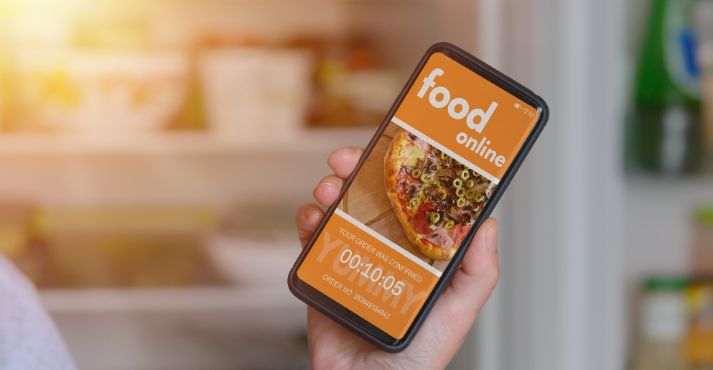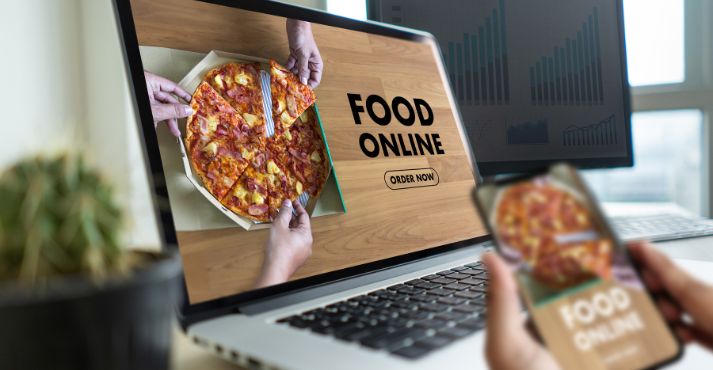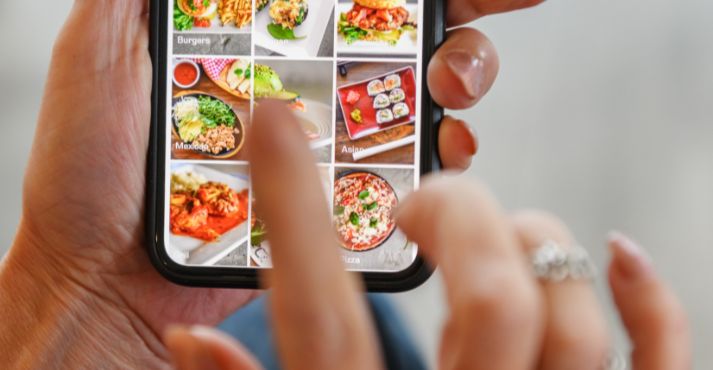Welcome to the modern dining landscape, where the concept of a food ordering system has become a game-changer. Technology has revolutionized how people order and experience food in this digital era.
The emergence of food ordering systems has seamlessly integrated convenience into our dining experiences, shaping a new era in how we interact with culinary delights.
This introduction delves into the significance of food ordering systems, exploring their transformative role in modern dining and the technological revolution that has redefined how we connect with our favorite meals.
What is a Food Ordering System?
A Food Ordering System is a food service technology solution that facilitates the seamless ordering process for customers and businesses. It leverages online platforms and integrated point-of-sale (POS) systems to streamline food ordering.
Core Components of a Food Ordering System
1. User-Friendly Interfaces:
The visual and interactive elements of the system that customers interact with to browse menus, make selections, and place orders. User-friendly interfaces enhance the overall customer experience, making the ordering process intuitive and efficient.
2. Menu Management:
The digital representation of a restaurant’s menu, allowing businesses to update offerings, prices, and descriptions in real-time. Menu management ensures accuracy and relevancy, providing customers with up-to-date information and enticing choices.
3. Order Processing and Confirmation:
The backend functionality processes incoming orders notifies the kitchen, and sends customer order confirmations. Efficient order processing reduces wait times, enhances kitchen workflow, and provides customers with timely confirmations.
4. Payment Integration:
The integration of secure payment gateways that allow customers to make online payments for their food orders. Payment integration ensures a seamless and secure transaction process, creating a hassle-free customer experience.
5. Real-Time Order Tracking:
A feature that enables customers to track the status of their orders in real-time, from preparation to delivery. Real-time order tracking enhances transparency, allowing customers to stay informed and businesses to optimize delivery logistics.
6. Integration with POS Systems:
The integration of the food ordering system with the restaurant’s Point of Sale (POS) system for synchronized order management. POS integration minimizes manual data entry, reduces errors, and ensures consistency between online and in-house orders.
7. Customer Feedback and Ratings:
A feature that allows customers to provide feedback and ratings based on their ordering and dining experiences. Customer feedback and ratings help businesses assess and improve their services, fostering a culture of continuous improvement.
8. Promotions and Loyalty Programs:
The inclusion of promotional offers, discounts, and loyalty programs to incentivize repeat business. Promotions and loyalty programs attract and retain customers, fostering a sense of appreciation and loyalty.
Types of Food Ordering Systems
Various types of Food Ordering Systems have emerged as the culinary landscape evolves, leveraging technology to meet customers’ diverse needs and preferences. Here, we explore the primary categories:
1. Online Food Ordering Platforms:
Web-based platforms that allow customers to browse menus, place orders, and make payments through a website.
Features:
- User-Friendly Interfaces: Intuitive online interfaces for seamless browsing and ordering.
- Order Tracking: Real-time updates on order status and delivery.
- Payment Integration: Secure online payment options for convenience.
2. Mobile Ordering Apps:
There are dedicated mobile applications that enable customers to order food using smartphones or tablets.
Features:
- User-Friendly App Design: Intuitive app interfaces for easy navigation.
- Push Notifications: Timely alerts on order updates, promotions, and discounts.
- In-App Payment: Integrated payment options for a streamlined checkout process.
3. Integrated POS Systems:
Point of Sale (POS) systems integrated with food ordering capabilities provide a comprehensive solution for in-house and online orders.
Features:
- Unified Order Management: Seamless coordination between in-house and online orders.
- Menu Synchronization: Real-time updates on menus across all ordering channels.
- Efficient Kitchen Workflow: Optimized processes for order processing and preparation.
4. Voice-Activated Ordering:
Systems that enable customers to place food orders using voice commands through virtual assistants or smart devices.
Features:
- Speech Recognition: Advanced technology for accurately interpreting voice commands.
- Personalized Recommendations: AI-driven suggestions based on user preferences.
- Hands-Free Convenience: Ordering without the need for manual input.
5. Social Media Ordering:
Integration of food ordering functionalities within popular social media platforms, allowing users to place orders without leaving the app.
Features:
- Seamless Integration: Direct access to food ordering options within social media interfaces.
- Social Sharing: Opportunities for users to share their food experiences and recommendations.
- Promotional Campaigns: In-app promotions to engage users and drive orders.
How Food Ordering Systems Work
Customer Ordering Process
Starting a culinary journey with a Food Ordering System is accessible for users. It’s designed to make ordering food smooth. Here’s a simple guide to how customers can place an order:
1. Menu Browsing:
- Customers start by browsing through a visually appealing and easily navigable online menu.
- Rich visuals, detailed descriptions, and categorized sections assist customers in making informed choices.
2. Order Customization:
- To cater to diverse preferences, food ordering systems often allow customization of menu items. Customers can modify ingredients, select portion sizes, and add specific instructions.
3. Adding to Cart:
- Once satisfied with their selections, customers add items to their virtual cart, which provides an overview of chosen items and total costs.
4. Checkout Process:
- The checkout process involves providing delivery details or selecting pickup options.
- Customers enter payment information securely through integrated payment gateways.
5. Order Confirmation:
After successful payment, customers receive an order confirmation with details such as expected delivery time or pickup instructions.
6. Order Tracking:
- For enhanced transparency, many food ordering systems offer real-time order tracking. Customers can monitor the status of their order from preparation to delivery.
7. Delivery or Pickup:
- Customers can choose between home delivery or restaurant pickup depending on their convenience.
- Real-time updates on delivery status keep customers informed.
Restaurant Management Process
Beyond providing a convenient ordering experience for customers, food ordering systems play a pivotal role in streamlining restaurant management processes. Here’s how:
1. Order Tracking and Fulfillment:
- Restaurants can efficiently track incoming orders, ensuring timely preparation and delivery.
- Order fulfillment updates contribute to operational efficiency.
2. Inventory Management:
- Integration with inventory management systems enables real-time tracking of ingredients and supplies.
- Automatic updates help prevent shortages and optimize stock levels.
3. Data Analytics for Insights:
- Food ordering systems collect valuable data on customer preferences, popular menu items, and peak ordering times.
- Restaurants can leverage this data to make informed decisions, plan promotions, and optimize their menu.
4. Operational Efficiency:
- Automation of processes, from order receipt to kitchen communication, enhances overall operational efficiency.
- Reduced manual errors contribute to a smoother workflow.
5. Customer Relationship Management (CRM):
- Food ordering systems often incorporate CRM features to manage customer relationships effectively.
- Insights from order histories enable personalized promotions and loyalty programs.
Benefits of Food Ordering Systems
Increased Efficiency

Food ordering systems revolutionize the dining landscape by infusing efficiency into customer experiences and restaurant operations. Here’s how:
1. Reduced Wait Times:
- One of the foremost benefits is the substantial reduction in wait times. Customers can seamlessly place orders in advance, minimizing the time spent waiting for tables or food preparation.
2. Streamlined Operations:
- Restaurants benefit from streamlined operations, with automated order processing, reducing manual errors and enhancing overall efficiency.
- Integrating digital restaurant technologies optimizes kitchen workflows, leading to quicker turnaround times.
3. Enhanced Order Accuracy:
- Automation minimizes the risk of order inaccuracies, ensuring customers receive precisely what they’ve chosen.
- Real-time communication between the kitchen and front-of-house improves accuracy in fulfilling orders.
Enhanced Customer Experience
Food ordering systems transcend the ordinary, delivering a heightened dining experience that caters to modern consumers’ preferences. Key elements include:
1. Convenience:
Customers enjoy the convenience of placing orders from the comfort of their homes or on-the-go, eliminating the need to wait in long queues or dine-in lines.
2. Customization Options:
Food ordering systems offer extensive customization options, allowing customers to tailor their orders according to personal preferences, dietary restrictions, and taste preferences.
3. Seamless Transactions:
The user-friendly interfaces of these systems contribute to seamless transactions. The process is designed for user convenience, from browsing menus to payment.
Data-Driven Insights
Beyond operational efficiency and improved customer experiences, food ordering systems unfold a treasure trove of data-driven insights that empower restaurants. These insights include:
1. Understanding Customer Preferences:
By analyzing order histories, restaurants gain profound insights into customer preferences, enabling them to tailor menus and promotions accordingly.
2. Optimizing Menus:
Restaurants can use data to identify popular dishes, optimize menu offerings, and introduce new items that align with customer tastes.
3. Strategic Decision Making:
Business intelligence derived from data-driven insights facilitates strategic decision-making. Restaurants can align marketing strategies, pricing, and promotions with the preferences of their target audience.
4. Enhanced Customer Loyalty:
Personalized promotions based on data insights enhance customer loyalty, fostering a solid and lasting relationship between restaurants and patrons.
Future Trends in Food Ordering Systems
Integration of AI and Chatbots
As we step into the future of dining experiences, the integration of artificial intelligence (AI) and chatbots is poised to redefine customer interactions within food ordering systems:
1. Conversational Ordering:
AI-driven chatbots will facilitate conversational ordering, allowing customers to place orders using natural language. This enhances user experience and caters to a more diverse users, including those less familiar with digital interfaces.
2. Smart Recommendations:
AI algorithms will analyze past ordering patterns, preferences, and contextual factors to provide intelligent and personalized menu recommendations. This feature not only assists customers in making choices but also boosts upselling opportunities for restaurants.
3. Enhanced Customer Interactions:
Chatbots will serve as virtual assistants, answering customer queries, providing real-time order updates, and offering a seamless, interactive experience throughout the ordering process.
Contactless and Mobile Payment Trends
The landscape of payment methods within food ordering systems is rapidly evolving, with a prominent shift towards contactless and mobile payments:
1. Digital Wallets:
Contactless payments through digital wallets will become increasingly prevalent. Users can swiftly and securely complete transactions using popular platforms, enhancing convenience and reducing the reliance on physical cards or cash.
2. Payment Security:
The focus on secure transactions will intensify, with robust encryption and authentication measures ensuring the protection of sensitive financial information. This builds trust and aligns with the heightened emphasis on data security in the digital age.
3. Seamless Transaction Experience:
Contactless and mobile payments offer a streamlined transaction experience, eliminating the need to exchange cash or cards physically. This aligns with the broader trend of creating frictionless, efficient customer processes.
4. Adaptation to Modern Lifestyles:
The growing preference for contactless payments resonates with modern lifestyles, providing a secure and hygienic alternative to traditional payment methods.
Conclusion
In wrapping up our exploration of food ordering systems, it’s evident that these technological innovations have profoundly transformed the dining experience.
The convenience and efficiency they bring have redefined how we connect with our favorite cuisines.
As we conclude, it’s exciting to anticipate the evolving trends that will shape the future of this technology.
Navigating the future of digital dining experiences promises even greater convenience and possibilities.
The journey doesn’t end here; it’s an ongoing evolution, and we’re poised to witness how food ordering systems continue to enhance and streamline our culinary adventures.















